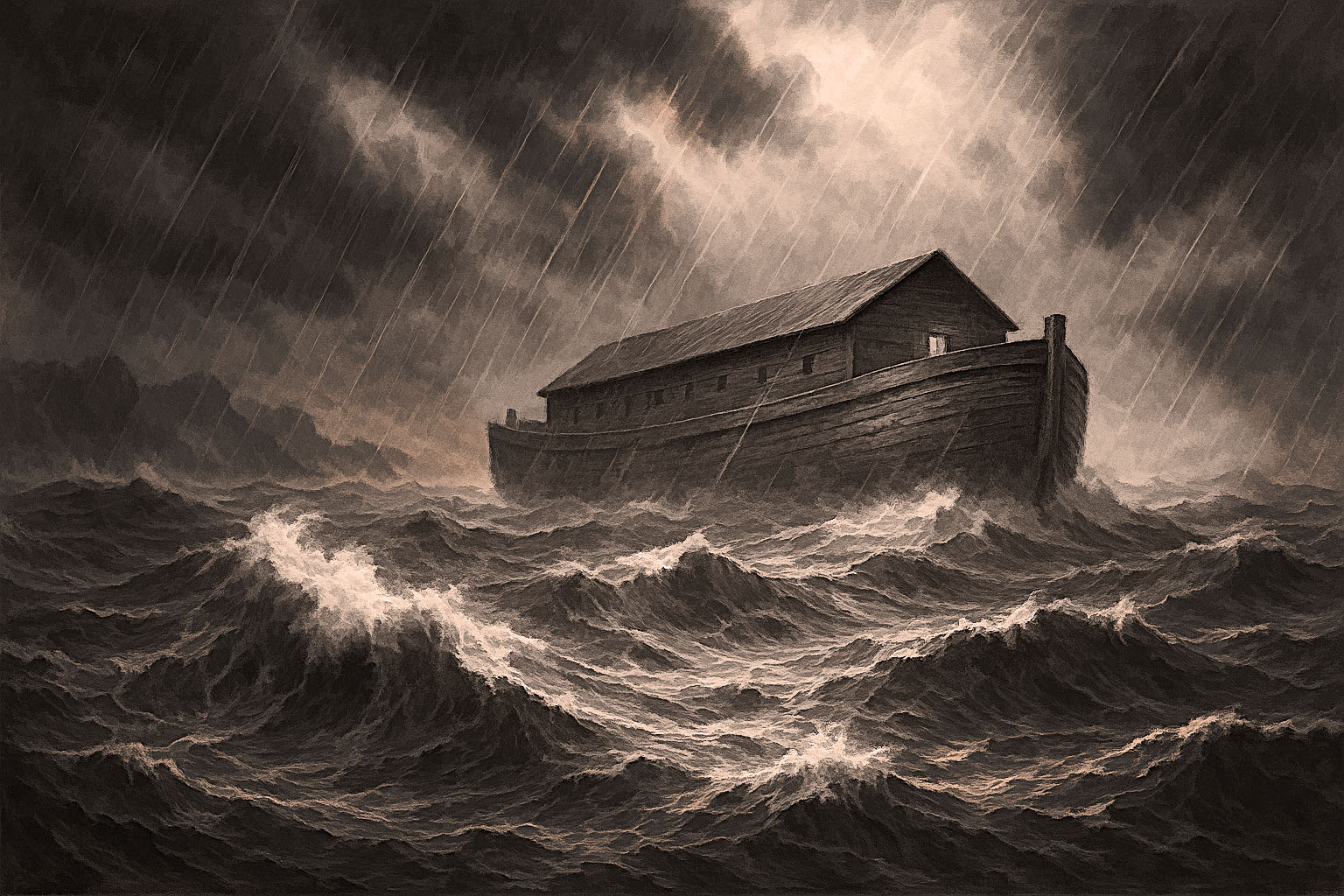
The Mystery of the Great Flood: Fact, Faith, and the Ark of Noah
Throughout history, cultures around the world have shared tales of a cataclysmic flood, a deluge so vast, so destructive, that it wiped out nearly all of humanity. From the story of Utnapishtim in the Mesopotamian Epic of Gilgamesh to the tale of Manu in Hindu mythology, these flood legends bear striking similarities. Yet none is more widely known, debated, or deeply ingrained in spiritual consciousness than the biblical story of Noah and the Great Flood.
In this post, we’ll dive deep into the mystery of the Great Flood. Was it just a myth or a historical event? What was the purpose of the flood, and what does it mean today? Is there any real-world evidence of such an event, or of Noah’s Ark itself? Let’s uncover the layers of this ancient tale.
The “Great Flood” refers to a massive, world-engulfing deluge described in ancient texts, particularly the Bible. It’s portrayed as a divine judgment meant to cleanse a corrupt world. In the biblical account, the Great Flood covered the earth with water, drowning everything except for Noah, his family, and the animals they preserved in a great Ark.
Outside of the Bible, flood myths appear in dozens of ancient cultures, from the Sumerians and Babylonians to Native Americans and Pacific Islanders. These stories vary in detail, but they share common elements: divine wrath, human wickedness, a chosen survivor, and a giant vessel.
In essence, the Great Flood is more than a meteorological event, it’s a universal symbol of destruction, purification, and rebirth.
What Was the Great Flood in the Bible
The biblical account of the Great Flood appears in Genesis chapters 6–9. According to the text, humanity had grown increasingly wicked and violent. “The Lord saw how great the wickedness of the human race had become on the earth,” the story tells us in Genesis 6:5, “and that every inclination of the thoughts of the human heart was only evil all the time.”
Grieved by human sin, God decided to wipe the earth clean with a flood. But one man, Noah, “found favor in the eyes of the Lord” (Genesis 6:8). God instructed Noah to build an ark, 450 feet long, 75 feet wide, and 45 feet high, to preserve his family and representatives of all land animals.
When the rain came, it lasted forty days and forty nights, and the waters “prevailed upon the earth” for 150 days (Genesis 7:24). After about a year, the waters receded, and Noah’s Ark came to rest on the “mountains of Ararat” (Genesis 8:4). God made a covenant never again to destroy the earth by flood, sealing it with a rainbow.
This story is not merely historical, it is deeply theological. It portrays sin, judgment, mercy, and redemption, all wrapped in divine sovereignty.
Why Did God Bring the Great Flood
The primary reason given in Scripture is human wickedness. Genesis describes a world filled with violence, corruption, and moral decay. God’s response was not impulsive wrath but a calculated, sorrowful act of justice.
In Genesis 6:6, we find a rare emotional glimpse into the divine: “The Lord regretted that he had made human beings on the earth, and his heart was deeply troubled.” This anthropomorphic depiction shows a grieving Creator, saddened by what His creation had become.
But judgment wasn’t the only purpose of the flood. It was also a reset, a purification of the earth. And crucially, God’s instructions to Noah included a plan for survival and renewal. The Ark was not just a vessel of escape; it was a seed of a new beginning. Through Noah, life was given a second chance.
The Great Flood, then, is both a warning and a promise. It speaks of God’s intolerance for evil, but also His commitment to redemption and continuity.
How Many Days Did the Flood Last While Noah Was in the Ark
The entire ordeal lasted over a year. Here’s a breakdown of the timeline based on Genesis:
Noah enters the Ark (Genesis 7:7).
Rain falls for 40 days and nights (Genesis 7:12).
Waters flood the earth for 150 days (Genesis 7:24).
Ark rests on Mount Ararat on the 17th day of the 7th month (Genesis 8:4).
Waters continue to recede over months.
Noah sends out a raven and doves to test dryness (Genesis 8:6–12).
Earth is dry and Noah exits the Ark in the second month of the following year (Genesis 8:14–19).
Altogether, Noah and his family were in the Ark for approximately 370 days, just over one year.
How Many People Did God Save from the Great Flood
According to Genesis 7:13, eight people were saved:
Noah
His wife
His three sons: Shem, Ham, and Japheth
Their wives
These eight individuals repopulated the earth after the flood. The biblical narrative places great importance on this number, signifying a fresh start for humanity. This family became the new ancestral line for all people groups.
Is There Any Evidence of the Great Flood
This question has intrigued scientists, theologians, and archaeologists for centuries. While the global extent of the biblical flood is debated, some scholars believe regional catastrophes may have inspired the legend.
Here are some compelling theories and findings:
1. The Black Sea Deluge Theory
In the late 1990s, geologists William Ryan and Walter Pitman proposed that a catastrophic flood occurred around 5600 BCE, when Mediterranean waters breached a natural dam and poured into the Black Sea basin. This event, they suggest, may have been the inspiration for flood myths in Mesopotamia and beyond.
2. Mesopotamian Flood Narratives
The Epic of Gilgamesh, dating to around 2100 BCE, features a flood remarkably similar to Noah’s. In it, the gods decide to flood the world, but one man (Utnapishtim) is warned and builds a boat. The parallels lend weight to the idea that a real event inspired multiple traditions.
3. Geological Evidence of Ancient Floods
Around the world, geologists have discovered sediment layers and fossilized sea creatures in locations far from any ocean. In some cases, this suggests ancient inland flooding. However, attributing these directly to Noah’s Flood remains speculative.
4. Cultural Universality
Over 200 cultures have flood myths. The sheer ubiquity suggests a shared memory of a monumental flood, possibly handed down orally across generations and continents.
Still, no scientific consensus exists confirming a single, global deluge as described in Genesis.
Is There Any Proof of Noah’s Ark
One of the most tantalizing and controversial subjects in biblical archaeology is the search for Noah’s Ark. Over the decades, numerous expeditions have sought evidence on Mount Ararat in modern-day Turkey, where the Ark supposedly came to rest.
Notable Claims and Discoveries:
1949–1980s: Aerial photographs and local testimonies described a boat-shaped formation near Mount Ararat, dubbed the “Durupınar site.” Some claimed this was the petrified remains of the Ark, but later investigations labeled it a natural formation.
2007: A group of evangelical explorers from Hong Kong and Turkey claimed they found wooden structures at 13,000 feet on Mount Ararat. Radiocarbon dating suggested ancient age, but the claim remains unverified and highly controversial.
Skeptical Consensus: Most scientists and archaeologists argue that no credible, verifiable evidence has yet been found. The terrain, politics, and natural dangers of Mount Ararat also make excavation exceedingly difficult.
To date, there is no definitive proof that Noah’s Ark has been discovered.
Is the Story of Noah True
This is perhaps the most profound and personal question.
From a Historical Viewpoint:
The absence of physical evidence means that the story, as written, remains unconfirmed by modern science. Yet, there is circumstantial support, geological, cultural, and textual, for a large-scale flood event in ancient history.
From a Theological Perspective:
For millions, the story of Noah is not primarily about historical fact, but spiritual truth. It is a story of faith, obedience, divine justice, and mercy. Whether or not the Ark lies buried under snow and stone, the moral of the story has resonated across millennia.
Jesus himself referenced Noah in the Gospels, particularly in relation to final judgment: “As it was in the days of Noah, so it will be at the coming of the Son of Man” (Matthew 24:37). This reinforces the spiritual significance of the flood narrative within Christian theology.
The Role of Faith:
For believers, the truth of Noah lies not in geological strata or carbon dating, but in the enduring relevance of its lessons: the call to righteousness, the consequences of evil, and the hope of salvation.
The Enduring Legacy of the Flood
The Great Flood remains one of the most enduring stories in human history, revered by the faithful, scrutinized by scientists, and reimagined by storytellers. Whether interpreted as literal history or sacred myth, the tale of Noah continues to spark questions that bridge the ancient and the modern.
Was it a global catastrophe or a regional disaster magnified through memory? Was Noah a historical figure or a symbolic archetype of obedience and faith? Was the Ark real, or is it a vessel of moral truth?
In the end, perhaps the enduring power of the Great Flood lies not in the water that once covered the earth, but in the questions it raises, the faith it stirs, and the hope it offers.




